冠词固定搭配
- 格式:ppt
- 大小:16.00 KB
- 文档页数:4
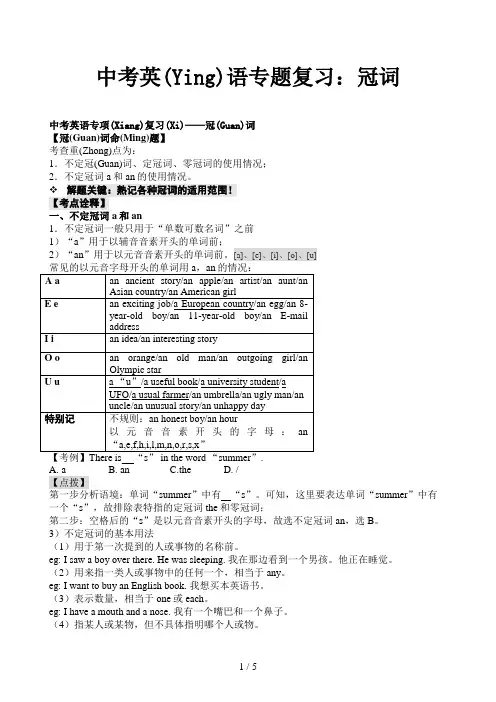
中考英(Ying)语专题复习:冠词中考英语专项(Xiang)复习(Xi)——冠(Guan)词【冠(Guan)词命(Ming)题】考查重(Zhong)点为:1.不定冠(Guan)词、定冠词、零冠词的使用情况;2.不定冠词a和an的使用情况。
❖解题关键:熟记各种冠词的适用范围!【考点诠释】一、不定冠词a和an1.不定冠词一般只用于“单数可数名词”之前1)“a”用于以辅音音素开头的单词前;2)“an”用于以元音音素开头的单词前。
[a]、[e]、[i]、[o]、[u]There is “A.aB. anC.theD. /【点拨】第一步分析语境:单词“summer”中有“s”。
可知,这里要表达单词“summer”中有一个“s”,故排除表特指的定冠词the和零冠词;第二步:空格后的“s”是以元音音素开头的字母,故选不定冠词an,选B。
3)不定冠词的基本用法(1)用于第一次提到的人或事物的名称前。
eg: I saw a boy over there. He was sleeping. 我在那边看到一个男孩。
他正在睡觉。
(2)用来指一类人或事物中的任何一个,相当于any。
eg: I want to buy an English book. 我想买本英语书。
(3)表示数量,相当于one或each。
eg: I have a mouth and a nose. 我有一个嘴巴和一个鼻子。
(4)指某人或某物,但不具体指明哪个人或物。
eg: A man is waiting for you at the gate. 有个(Ge)人在门口等你。
(5)表(Biao)示类别,泛指一类人或物。
eg: A horse is much bigger than a rabbit. 马比兔子大得(De)多。
(6)表(Biao)示(Shi)“每(Mei)一(Yi)”的(De)意思,相当于every。
eg: once a week 一周一次200 kilometers an hour 每小时200公里(7)用在such,quite,rather,half,what等词之后。
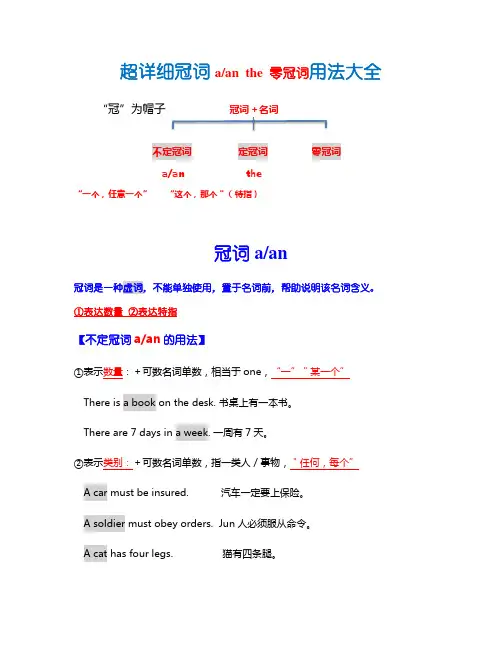
超详细冠词a/an the 零冠词用法大全“冠”为帽子冠词+名词不定冠词定冠词零冠词a/an the“一个,任意一个”“这个,那个"(特指)冠词a/an冠词是一种虚词,不能单独使用,置于名词前,帮助说明该名词含义。
①表达数量②表达特指【不定冠词a/an的用法】①表示数量:+可数名词单数,相当于one,“一”"某一个”There is a book on the desk. 书桌上有一本书。
There are 7 days in a week. 一周有7天。
②表示类别:+可数名词单数,指一类人/事物,"任何,每个”A car must be insured. 汽车一定要上保险。
A soldier must obey orders. Jun人必须服从命令。
A cat has four legs. 猫有四条腿。
③表示“每一"。
多用在价格/速度/比率/频率等短语中。
twice a month 每个月两次one dollar a kilo 每公斤1美元3 times a day 每天三次six kilometers an hour 每小时60公里④用于第一次提到的人或事物,不是特指There is a box in the room. The box is heavy.房间里有个箱子。
这个箱子很重。
I have a watch. It is very expensive.我有一块手表。
这表很贵。
⑤和名词连用作表语或同位语,主要说明某个人或东西所属类别(性质)My father is a fireman. 我的父亲是一名消防员。
We all thought him a suitable person for the job.我们都认为他是适合做这个项目的人。
⑥用于部分专有名词前1)a/an+姓名专有名词:“叫……(名)的人“或”像……那样的人A Mr Black is looking for you. 有位布莱克先生在找你。
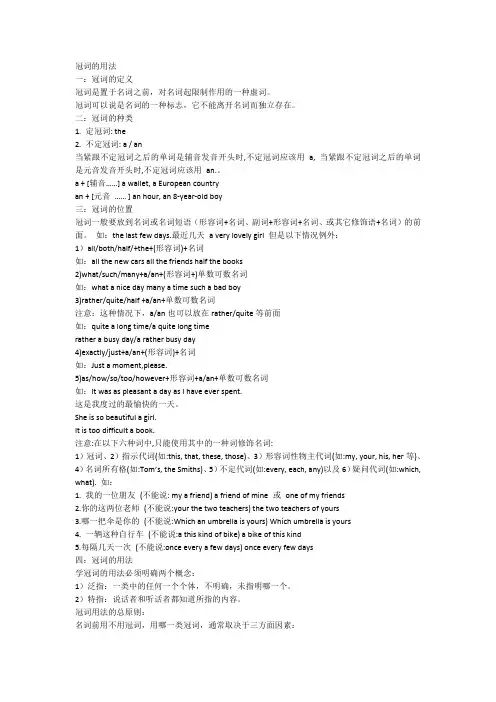
冠词的用法一:冠词的定义冠词是置于名词之前,对名词起限制作用的一种虚词。
冠词可以说是名词的一种标志,它不能离开名词而独立存在。
二:冠词的种类1. 定冠词: the2. 不定冠词: a / an当紧跟不定冠词之后的单词是辅音发音开头时,不定冠词应该用a, 当紧跟不定冠词之后的单词是元音发音开头时,不定冠词应该用an.。
a + [辅音……] a wallet, a European countryan + [元音…… ] an hour, an 8-year-old boy三:冠词的位置冠词一般要放到名词或名词短语(形容词+名词、副词+形容词+名词、或其它修饰语+名词)的前面。
如:the last few days.最近几天 a very lovely girl 但是以下情况例外:1)all/both/half/+the+(形容词)+名词如:all the new cars all the friends half the books2)what/such/many+a/an+(形容词+)单数可数名词如:what a nice day many a time such a bad boy3)rather/quite/half +a/an+单数可数名词注意:这种情况下,a/an也可以放在rather/quite等前面如:quite a long time/a quite long timerather a busy day/a rather busy day4)exactly/just+a/an+(形容词)+名词如:Just a moment,please.5)as/how/so/too/however+形容词+a/an+单数可数名词如:It was as pleasant a day as I have ever spent.这是我度过的最愉快的一天。
She is so beautiful a girl.It is too difficult a book.注意:在以下六种词中,只能使用其中的一种词修饰名词:1)冠词、2)指示代词(如:this, that, these, those)、3)形容词性物主代词(如:my, your, his, her等)、4)名词所有格(如:Tom’s, the Smiths)、5)不定代词(如:every, each, any)以及6)疑问代词(如:which, what). 如:1. 我的一位朋友(不能说: my a friend) a friend of mine 或one of my friends2.你的这两位老师(不能说:your the two teachers) the two teachers of yours3.哪一把伞是你的(不能说:Which an umbrella is yours) Which umbrella is yours4. 一辆这种自行车(不能说:a this kind of bike) a bike of this kind5.每隔几天一次(不能说:once every a few days) once every few days四:冠词的用法学冠词的用法必须明确两个概念:1)泛指:一类中的任何一个个体,不明确,未指明哪一个。
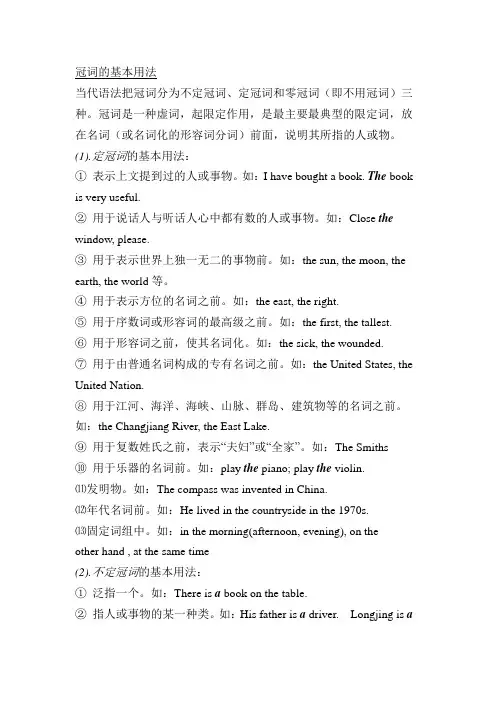
冠词的基本用法当代语法把冠词分为不定冠词、定冠词和零冠词(即不用冠词)三种。
冠词是一种虚词,起限定作用,是最主要最典型的限定词,放在名词(或名词化的形容词分词)前面,说明其所指的人或物。
(1).定冠词的基本用法:①表示上文提到过的人或事物。
如:I have bought a book. The book is very useful.②用于说话人与听话人心中都有数的人或事物。
如:Close the window, please.③用于表示世界上独一无二的事物前。
如:the sun, the moon, the earth, the world等。
④用于表示方位的名词之前。
如:the east, the right.⑤用于序数词或形容词的最高级之前。
如:the first, the tallest.⑥用于形容词之前,使其名词化。
如:the sick, the wounded.⑦用于由普通名词构成的专有名词之前。
如:the United States, the United Nation.⑧用于江河、海洋、海峡、山脉、群岛、建筑物等的名词之前。
如:the Changjiang River, the East Lake.⑨用于复数姓氏之前,表示“夫妇”或“全家”。
如:The Smiths⑩用于乐器的名词前。
如:play the piano; play the violin.⑾发明物。
如:The compass was invented in China.⑿年代名词前。
如:He lived in the countryside in the 1970s.⒀固定词组中。
如:in the morning(afternoon, evening), on theother hand , at the same time(2).不定冠词的基本用法:①泛指一个。
如:There is a book on the table.②指人或事物的某一种类。

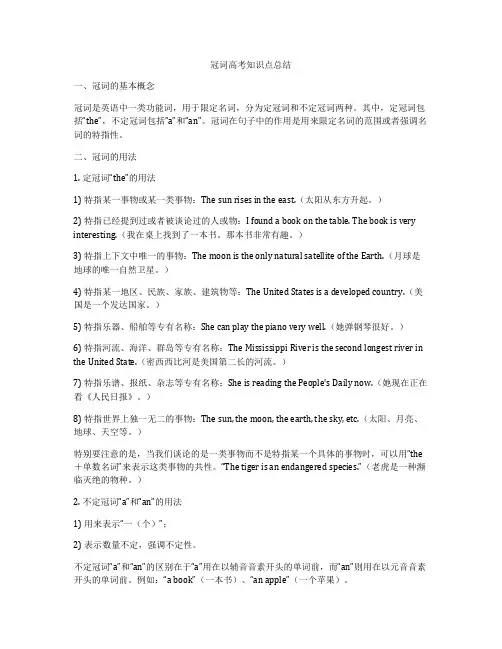
一、冠词的基本概念冠词是英语中一类功能词,用于限定名词,分为定冠词和不定冠词两种。
其中,定冠词包括“the”,不定冠词包括“a”和“an”。
冠词在句子中的作用是用来限定名词的范围或者强调名词的特指性。
二、冠词的用法1. 定冠词“the”的用法1) 特指某一事物或某一类事物:The sun rises in the east.(太阳从东方升起。
)2) 特指已经提到过或者被谈论过的人或物:I found a book on the table. The book is very interesting.(我在桌上找到了一本书。
那本书非常有趣。
)3) 特指上下文中唯一的事物:The moon is the only natural satellite of the Earth.(月球是地球的唯一自然卫星。
)4) 特指某一地区、民族、家族、建筑物等:The United States is a developed country.(美国是一个发达国家。
)5) 特指乐器、船舶等专有名称:She can play the piano very well.(她弹钢琴很好。
)6) 特指河流、海洋、群岛等专有名称:The Mississippi River is the second longest river in the United State.(密西西比河是美国第二长的河流。
)7) 特指乐谱、报纸、杂志等专有名称:She is reading the People's Daily now.(她现在正在看《人民日报》。
)8) 特指世界上独一无二的事物:The sun, the moon, the earth, the sky, etc.(太阳、月亮、地球、天空等。
)特别要注意的是,当我们谈论的是一类事物而不是特指某一个具体的事物时,可以用“the +单数名词”来表示这类事物的共性。
“The tiger is an endangered species.”(老虎是一种濒临灭绝的物种。
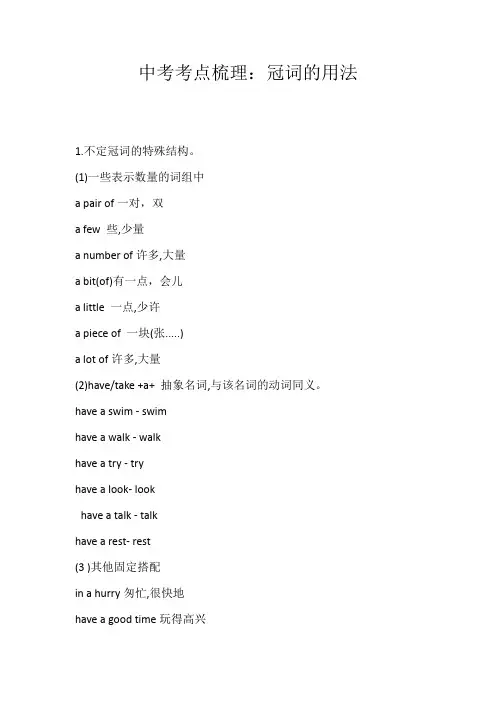
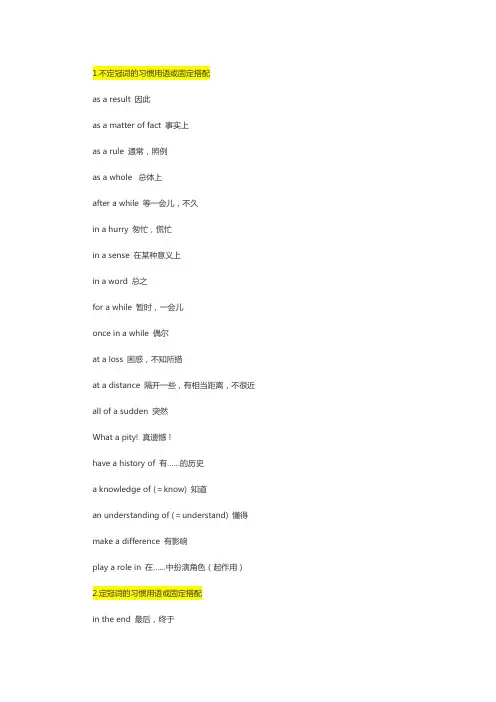
1.不定冠词的习惯用语或固定搭配as a result 因此as a matter of fact 事实上as a rule 通常,照例as a whole 总体上after a while 等一会儿,不久in a hurry 匆忙,慌忙in a sense 在某种意义上in a word 总之for a while 暂时,一会儿once in a while 偶尔at a loss 困惑,不知所措at a distance 隔开一些,有相当距离,不很近all of a sudden 突然What a pity! 真遗憾!have a history of 有……的历史a knowledge of (=know) 知道an understanding of (=understand) 懂得make a difference 有影响play a role in 在……中扮演角色(起作用)2.定冠词的习惯用语或固定搭配in the end 最后,终于make the most/best of 充分利用in the distance 在远处in the way 挡路on the whole 总之on the right/left 在右/左面at the same time 同时at the moment 此刻,目前go to the doctors 去看医生by the way 顺便说说,附带提一下the other day(=a few days ago) 几天前on the spot在场,到场;立即,马上;当场to tell (you) the truth 说实话,老实说go to the cinema 去看电影take the place of 替代3.零冠词的习惯用法或固定搭配under repair处于维修中lose heart 灰心day and night 整天整夜out of control 失控out of work 失业in danger 处于危险中,在危险之中at risk 处于危险之中,处境危险at present 目前in peace 平静by chance/accident 碰巧on purpose 故意on second thought 经再次考虑,重新考虑后ahead of time 提前in advance 提前by law 根据法律by mistake 错误地,无意地take part in 参加。

Unit 1一、a an和the的用法球类运动前面不用冠词在操场上是固定搭配on the playground(一)不定冠词:a∕an的用法:⑴表示一个例:She has a clever son. 她有个聪明的儿子。
⑵表示每个例:we have 3 English classes a week. 我们每周上3次英语课。
⑶表示某个例:The book is∕was written by a student.这本书是一个学生写的。
⑷表示某类之一例:I am a teacher ,he is a doctor. 我是一名老师,他是一名医生。
⑸第一次提到的人或物用不定冠词表示,再次提到时用定冠词。
例:I have a bike,the bike is green. 我有一辆自行车,这辆自行车是绿色的。
⑹用于可数名词单数形式前,表示类别。
例:A teacher must love his student. 老师应该爱学生。
(二)定冠词the的用法:⑴表示特定的人或事物例:The book on the desk is mine. 桌子上的书是我的。
⑵表示听话人,说话人彼此都很熟悉的人或事物例:Where is Tom? 汤姆在哪儿?He is in the room. 他在屋里。
⑶第一次提到的人或物用不定冠词表示,再次提到时用定冠词。
例:I have a bike,the bike is green. 我有一辆自行车,这辆自行车是绿色的。
⑷表示世界上独一无二的东西(专有名词除外)例:The sun 太阳⑸表示国家,党派,团体,机关等词组前用定冠词例:The Communist Party 共产党⑹用在表示乐器的名词前例:Play the piano 弹钢琴(7)用在序数词,形容词最高级和表示方位的名词前(副词最高级前可以不用)例:the fattest girl 最胖的女孩儿in the east 在东边(8)用在地理名词前(江河湖海…)例:The yellow river 黄河(三)零冠词(不用冠词)的情况⑴专有名词前不用冠词(由普通名词构成的专有名词以及某些特殊情况除外)例:China 中国⑵物质名词,抽象名词,可数名词复数形式表示一般概念时不用冠词例:Children will children. 孩子总是孩子。
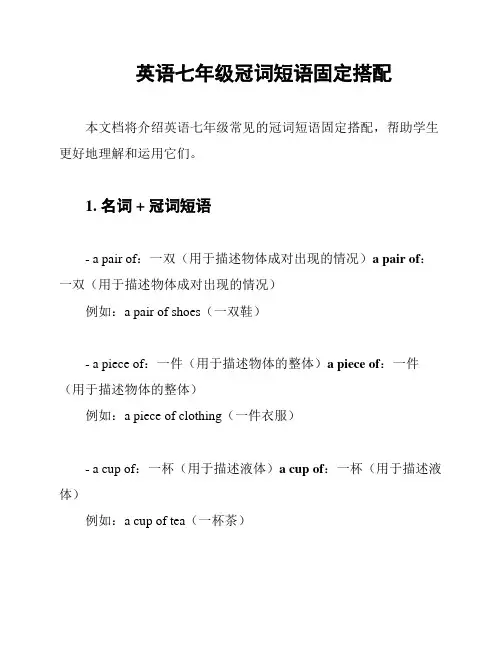
英语七年级冠词短语固定搭配本文档将介绍英语七年级常见的冠词短语固定搭配,帮助学生更好地理解和运用它们。
1. 名词 + 冠词短语- a pair of:一双(用于描述物体成对出现的情况)a pair of:一双(用于描述物体成对出现的情况)例如:a pair of shoes(一双鞋)- a piece of:一件(用于描述物体的整体)a piece of:一件(用于描述物体的整体)例如:a piece of clothing(一件衣服)- a cup of:一杯(用于描述液体)a cup of:一杯(用于描述液体)例如:a cup of tea(一杯茶)- a bottle of:一瓶(用于描述液体)a bottle of:一瓶(用于描述液体)例如:a bottle of water(一瓶水)2. 形容词 + 冠词短语- a kind of:一种(用于描述事物的种类)a kind of:一种(用于描述事物的种类)例如:a kind of fruit(一种水果)- a lot of:许多(用于描述大量的事物)a lot of:许多(用于描述大量的事物)例如:a lot of books(许多书)- a few:几个(用于描述数量不多的事物)a few:几个(用于描述数量不多的事物)例如:a few pencils(几支铅笔)- a little:一点(用于描述数量不多的事物)a little:一点(用于描述数量不多的事物)例如:a little sugar(一点糖)- a great deal of:大量(用于描述大量的事物)a great deal of:大量(用于描述大量的事物)例如:a great deal of money(大量的钱)3. 动词 + 冠词短语- have a:有一个(用于描述拥有某种特质或情况)have a:有一个(用于描述拥有某种特质或情况)例如:have a headache(头疼)- take a:吃一(用于描述吃药或感受)take a:吃一(用于描述吃药或感受)例如:take a shower(洗澡)- make a:做一个(用于描述制作或创建某物)make a:做一个(用于描述制作或创建某物)例如:make a cake(做蛋糕)- give a:给一个(用于描述给予或赠送某物)give a:给一个(用于描述给予或赠送某物)例如:give a present(给礼物)以上是一些英语七年级常见的冠词短语固定搭配,希望对学生们的英语学习有所帮助。
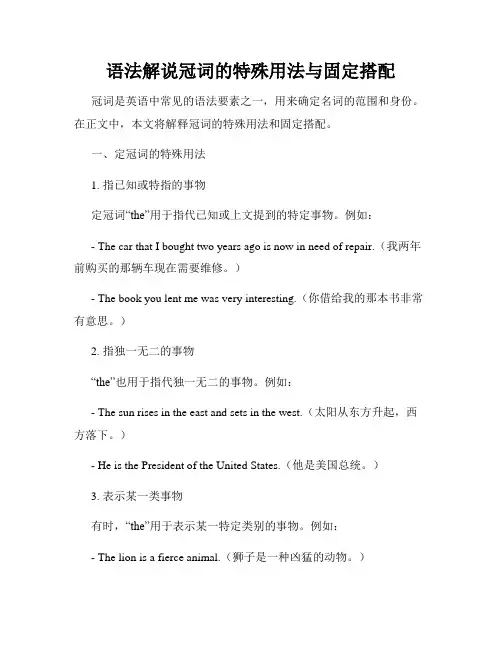
语法解说冠词的特殊用法与固定搭配冠词是英语中常见的语法要素之一,用来确定名词的范围和身份。
在正文中,本文将解释冠词的特殊用法和固定搭配。
一、定冠词的特殊用法1. 指已知或特指的事物定冠词“the”用于指代已知或上文提到的特定事物。
例如:- The car that I bought two years ago is now in need of repair.(我两年前购买的那辆车现在需要维修。
)- The book you lent me was very interesting.(你借给我的那本书非常有意思。
)2. 指独一无二的事物“the”也用于指代独一无二的事物。
例如:- The sun rises in the east and sets in the west.(太阳从东方升起,西方落下。
)- He is the President of the United States.(他是美国总统。
)3. 表示某一类事物有时,“the”用于表示某一特定类别的事物。
例如:- The lion is a fierce animal.(狮子是一种凶猛的动物。
)- We should protect the environment.(我们应该保护环境。
)二、不定冠词的特殊用法1. 表示泛指或不确定的事物不定冠词“a”(或其变体an)用于表示泛指或不确定的事物。
例如:- I saw a bird in the tree.(我看见树上有一只鸟。
)- She is an English teacher.(她是一名英语教师。
)2. 表示数量为一的事物不定冠词也可以表示数量为一的事物。
例如:- I have a pen in my bag.(我包里有一支笔。
)- Could you lend me a dollar?(你能借我一美元吗?)三、冠词固定搭配1. at the end of(在...的尽头)- We found a beautiful garden at the end of the street.(我们在这条街的尽头发现了一个美丽的花园。
专题06 短文改错高频考点TOP 6 冠词考点一单数可数名词不“裸奔”,表泛指加a/an, 表特指加the定冠词the用来限定这个冠词后面的名词是某个特定的事物,即“特指”例如:Liming went to buy the book that his teacher asked him to.(the已经被指定“老师让他买的书”)不定冠词a/an用来表示这个冠词后面的名词是指一类特定事物中的一个,但具体是哪一个并不知道。
即“泛指”。
1)Hello,everyone. It's nice to speak about that we can do for our school,and I think small actions can make bigdifference.【答案】make后加a【解析】句意:我认为小行动能有大改变,此处应该表示泛指2)My dream is to become successful doctor【答案】become后加a【解析】句意:我的梦想是成为一名成功的医生,“医生”表示泛指3)This is the very good way of spending her free time.考点二元音、辅音开头,a/an之间的误用a 用于读音以辅音音素开头的字母或单词前。
例如:a pen 一支笔,a book 一本书。
an用语读音以元音音素开头的字母或单词前。
例如:an apple 一只苹果, an orange 一颗橙子, an egg 一颗鸡蛋, an English book 一本英语书。
注:特殊用法1)有些单词的首字母虽然是以元音字母开头,但是,当它的读音是以辅音音素开头的时候,它前面的冠词就不能和一般元音字母开头的单词一样用an,而是应该用冠词a。
例如: a useful book 一本有用的书(单词“useful”虽然以元音字母u开头,但是它的读音却是以辅音因素开头的[ˈjusfəl],所以它的前面不可以用冠词an,而是要用冠词a)。
第二讲冠词、介词(短语)冠词[思维导图]Ⅰ.冠词的基本用法一、不定冠词1.表示类指或指某类中的任何一个。
A virus is a very small living thing that causes disease.病毒是一种引发疾病的微生物。
2.表示泛指。
当说话人第一次提及某人或某物时通常用不定冠词,因此由不定冠词构成的名词词组往往带有不确定的含义,相当于a certain。
Experts think that the recently discovered painting may be a Picasso.专家们认为最近发现的那幅画可能是毕加索的作品。
3.表示量指。
不定冠词表示“一”这个数量,但数的概念没有one强烈。
Suddenly they heard a loud voice.他们突然听到砰的一声噪音。
4.表示“每”,相当于per,用在表示价格、速度、频率等的短语中。
Prices start at £13.95 a yard for printed cotton.印花棉布以每码13.95英镑的价格起售。
5.表示“同一,相同”,相当于the same。
They happen to be of an age and wear clothes of a color.他们碰巧同龄而且穿着同样颜色的衣服。
6.用在某些物质名词或抽象名词前,使之具体化。
这样的物质名词有:rain,snow,fog,wind,drink,coffee,beer,fire,paper等;抽象名词有:success,failure,surprise,pleasure,beauty,wonder,comfort,danger,shock等。
He suddenly appeared on a rainy night,which was a great surprise to us.他在一个雨夜突然出现,这使我们非常吃惊。
A 用于以辅音因素或者半元音因素/j/,/w/开头的单词。
An 用于元音因素开头的单词注意:元音因素开头的单词,首字母不一定就是元音字母例如,hour,honest 等单词,看起来是以辅音字母开头,但是发音时辅音字母h 没有发音,而是以元音开头,因此前面应加不定冠词an。
而有些单词如university,uniform 等单词,是以元音字母u 开头,但是读音时u 发半元音/j/开头,所以前面应加a。
(1)用于可数名词的单数前,表示数量“一”,如:I have a new pen.(2) 表示一类人或者物,如:An elephant is big and strong.(3) 第一次提到的人或者物,如:Look, a dog is running to us.(4) 表示“每一”的意思,如:I go shopping once a week.have a look 看一下take a break 歇息一下in a hurry 急匆匆地a lot of 许多,大量have a good time 玩得愉快take a walk 散步half an hour 半小时a great deal of 大量+不可数名词a number of 许多+可数名词a few 一些+可数名词a little 一些+不可数名词(1)特指某些人或者物,例如:The woman in red dress is my mother.(2) 特指前面提到过的人或者物,例如:I have a dog. The dog is cute.(3) 指谈话双方都知道的人或者事物。
What do you think of the novel?(4) 指宇宙间独一无二的东西,如:The moon is bright at night.(5) 用于单数名词前表示一类人或者物,如:The horse is a useful animal.(6) 用于序数词前,如:、January is the first month of the year.(7) 用于形容词的最高级前面,如:John is the tallest student in my class.(8) 用于方位和位置前,如:At the top of at the back of at the bottom of at the middle of (9) 用于某些专有名词前,如:the Yangtze River the Great Wallthe United Nations the Summer Palace(10) 用于姓氏复数前,表示一家人,如:The Wangs are having dinner now。
常考冠词的固定搭配1.不定冠词的习惯用语或固定搭配as a result 因此as a matter of fact 事实上as a rule 通常,照例as a whole 总体上after a while 等一会儿,不久in a hurry 匆忙,慌忙in a sense 在某种意义上in a word 总之for a while 暂时,一会儿once in a while 偶尔at a loss 困惑,不知所措at a distance 隔开一些,有相当距离,不很近all of a sudden 突然What a pity! 真遗憾!have a history of 有……的历史a knowledge of (=know) 知道an understanding of (=understand) 懂得make a difference 有影响play a role in 在……中扮演角色(起作用)2.定冠词的习惯用语或固定搭配in the end 最后,终于make the most/best of 充分利用in the distance 在远处in the way 挡路on the whole 总之on the right/left 在右/左面at the same time 同时at the moment 此刻,目前go to the doctor 去看医生by the way 顺便说说,附带提一下the other day(=a few days ago) 几天前on the spot在场,到场;立即,马上;当场to tell (you) the truth 说实话,老实说go to the cinema 去看电影take the place of 替代3.零冠词的习惯用法或固定搭配under repair处于维修中lose heart 灰心day and night 整天整夜out of control 失控。
冠词一、不定冠词a/an1、泛指单数的人或物:a用在以辅音发音开头的单数可数名词前;an用在以元音发音开头的单数可数名词前。
例:My brother Fred woke up with a bad headache,yet by the evening the pain had gone.(2014,绍兴)Cathy was very happy to meet an old friend on the plane to Paris.(2014,温州)①常见的以辅音发音开头的单词a (useful machine university boy desk )②常见的以元音发音开头的单词an (orange eraser egg elephant animal apple eye idea answer umbrella arm hour interesting impolite importanteasy old )2、第一次提到某人或某物,而非特指。
例:There is a book on the desk.3、表示人或事物的某一类。
例:An elephant is bigger than a tiger.4、用于时间、速度、价格等名词前,有“每一”的意思,相当于every。
例:An apple a day keeps the doctor away.Three times a week5、固定搭配。
例:have a good timewait a minutea lot a few a little二、定冠词the1、用于特指某人或某物,双方都知道的人或物的名词前或用于第二次提到的某人或某物前。
例:The book on the desk is Jim’s.There is a picture on the wall;the picture is mine.Where is the ruler?2、用于世界上独一无二的事物的名词前。
高考冠词固定搭配常记(高频)不定冠词短语:a bit (of)有一点 a few 一些 a great deal 大量 a kind of 一种after a while一会儿后 a little 一点 a good /great many大量 a number of 很多a lot of 很多 a pair of一个/张/块等 a quantity of一些a pair of一双/副/对 a moment ago一会之前all of a sudden突然 as a rule通常 as a result因此 as a matter of fact事实上at a loss不知所措亏本 a waste of 奢侈 a matter of 大约左右at a distance(保持肯定距离) do a good deed做好事do sb . a favor帮某人忙 once upon a time(从前) have/take a rest(休息)for a while 短暂 get a lift/ride (搭车) go on a diet(用规定食谱, 节食)have a look 看一看 have a walk 漫步 have a break休息一下have a try试一试 take /have a bath洗澡 have a swim游泳have a cold have a good/happy time have a gift for(对有天赋)have a holiday休假,度假,放假 have a population of 有多少人口have a history of 有多长的历史 give a shout 大喊 make a choice 做出选择make a decision 做出确定 make a plan 制定安排 make a suggestion提个建议half an hour半小时 in a moment马上 once in a while间或in a hurry急匆忙 in a word总之 once upon a time从前 once in a while (时时常间或) make an effort/efforts努力 make a living谋生make a mistake犯错误 make an apology致歉 pay a visit探望give sb a hand帮某人 keep an eye on照看;关注 have a fever发烧have a pain难受 have a cough咳嗽 in a way在某种程度上have a word with sb与某人交谈 Have words with sb 与某人吵架come to an end结束 Come to an agreement同意lead/live a happy life 过着欢乐的生活 take a rest /break 休息一下 turn a deaf ear to充耳不闻 turn a blind eye to视而不见定冠词某些固定词组:make the most/best 0f(充分利用) in the daytime(在白天) in the end in the habit of (有…的习惯经常) not in the least =not at all (毫不)in the distance(在远处) in the way(挡路) on the whole(大体上) on the righton the one hand on the other hand at the same time at the momentgo to the cinema the other day (前几天) for the time being(暂且)on the radio on the spot(马上当场) to tell the truth(说实话) by the way on the left在左边 in the east在东边 on the other hand 在另一边in the end 在最终 in the daytime在白天 to tell the truth说实话on the contrary相反 in the middle of 在…中间 go to the cinema去看电影at the age of 在…岁时 at the very start一起先 on the air正在广播on the way 在途中 on the whole整体上 from the behind从后面to the right朝右边 to the amount of总计达 to the east of在…东方to the full完全的 in the morning/afternoon/evening 在上午/中午/晚上零冠词:knife and fork mother and son at dawn/daybreak/duskat first sight second to none (数一数二)on second thoughts(进一步考虑后) come to light(显露,大家熟知)side by side肩并肩 little by little慢慢地 year by year一年年地catch (a)cold感冒 for the lack 由于缺乏take/have(an)interest in 对…感有爱好 in (the)face of面临着take pride in以…骄傲 come to office=take office(就职) give birth to(引起,产生)in case of(假如,万一) out of order(故障,违反规章)in use in debt(欠债) under repair(正在修理)day and night side by side(相互支持,一起)shoulder to shoulder hand in hand by weight(按重量)by mistake(错误地) in place of(代替) catch fire(着火)for certain(无疑地)定冠词词/不定冠词区分:a number of 若干,一些the number of ……的数目(号码)at a cost of 以……为价格at the cost of 以……为代价for a moment 一会儿,片刻for the moment 短暂,目前in a fashion 以……方式(样子) in the fashion 赶时髦,随大流of a day 短命的,昙花一现of the day 当时的,当代的of an age 同年of the age 当代的,现代的to a point 在某种程度上to the point 中肯,扼要,切题to an end 结束to the end 究竟零冠词和定冠词的区分at table (正在)进餐at the table 在桌子旁by sea 乘船,走水路by the sea 在海边,在海岸上by day 在白天by the day 按日计算go to sea 当水手go to the sea 到海边去go to school 上学go to the school 到这(那)所学校去in care of 由……转交in the care of 由……照管in charge of 负责in the charge of 由……来说;至于in course of 正在……之中in the course of 在……期间in court 在法庭上in the court 在院子里in front of 在……前面in the front of 在……前面部位in open 公开地in the open 在户外in point of 就…而言,关于 in the point of 立刻,刚要in possession of 占有,拥有 in the possession of 被……占有(拥有)A +in charge of+B A限制BA+in charge of +B B限制Ain red (穿)红色衣服in the red 亏损,赤字in rough 用草稿的方式in the rough 大约,大致in secret 隐私地,私下地 in the secret 参加隐私,知道内情of age 成年of the age 当代的,现代的out of question 毫无疑问 out of the question 不行能的at school 上学at the school在学校by day白天by the day按日计算in hospital住院in the hospital在医院in charge of掌管in the charge of在…掌管之中in place of取代in the place of在…的位置上in front of在…前面in the front of在…的前端in office执政in the office在办公室内go to bed上床睡觉go to the bed朝床边走去go to church做礼拜go to the church去教堂leave school 辍学leave the school离开学校take place发生take the place of代替live on farm务农live on the farm住在农场two of us 我们中的两个the two of us我们两个零冠词和不定冠词的区分at birth 诞生时 at a birth 一胎生in word 在口头上 in a word 总而言之,简言之of age 成年 of an age 同年take note of 留意到 take a note of 把……记录下来take account of 考虑到 take an account of 把……登帐冠词的省略:from north to south 从北到南from east to west 从东到西from beginning to end 从头至尾day after day日复一日 day by day一每天地face to face面对面 hand in hand手拉手shoulder to shoulder肩并 arm in arm臂挽臂side by side肩并肩 little by little慢慢地year by year一年年地不用冠词:at college在上高校 at dark 天黑时at dawn 拂晓时 at dinner在吃饭at home 在家里 at peace处于和平状态catch hold of抓住 come back to life醒悟in addition另外 in advance 预先in good condition状况良好 in good order 有条不紊keep in touch with 与…保持联系 l earn …by heart背诵lose weight减肥 on business 因公出差 on foot 步行by air/car/bus/ship 乘飞机 pay attention to留意。